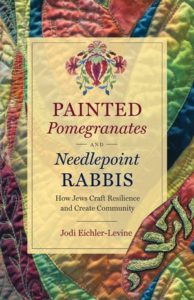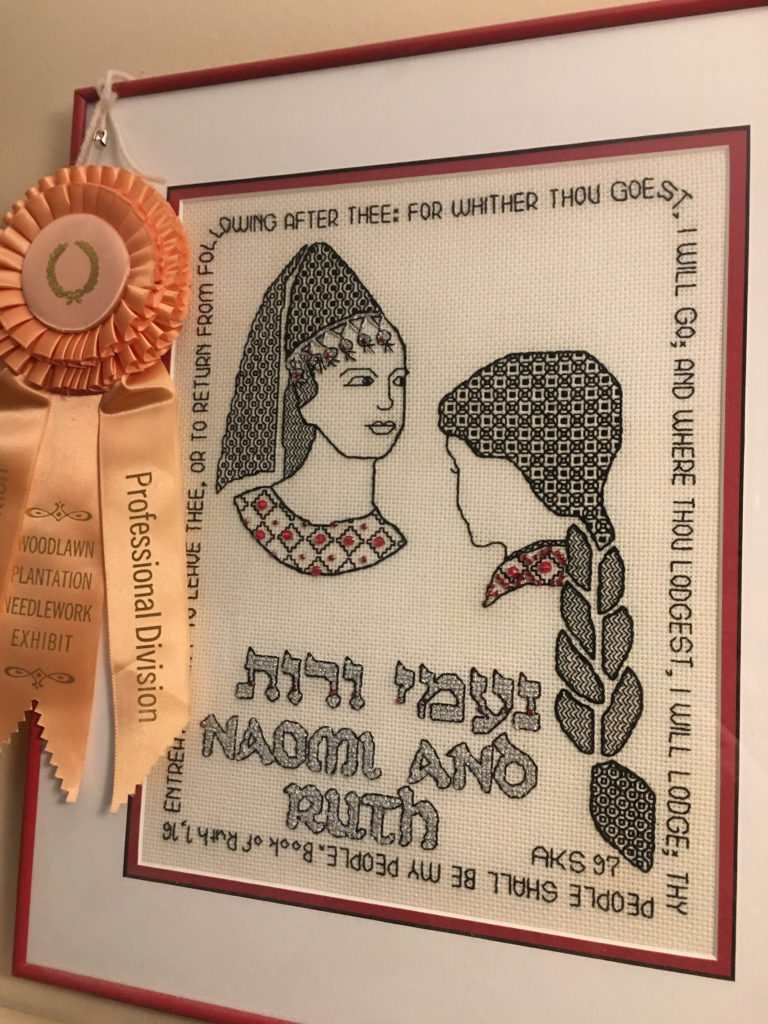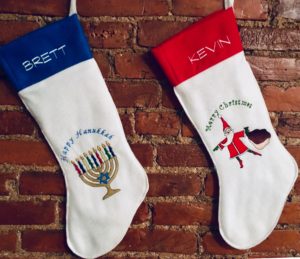"The Christmas Crafts are Just Out of Control": Pomegranate Guild as Jewish Space
An excerpt from the book Painted Pomegranates and Needlepoint Rabbis: How Jews Craft Resilience and Create Community
The following excerpt comes from Jodi Eichler-Levine’s newest book Painted Pomegranates and Needlepoint Rabbis: How Jews Craft Resilience and Create Community (Copyright © 2020 by the University of North Carolina Press. Used by permission of the publisher. www.uncpress.org). The book explores Jewish crafters, many of them women, and their contributions to American Jewish culture.
The following excerpt comes from the book’s fourth chapter.
***
 The Pomegranate Guild functions as a Jewish haven in the typically Christian-dominated American craft world. This came up in many casual conversations during my convention fieldwork and also, frequently, during formal interviews. As Bonnie told me: “I found other Jewish women who were doing Jewish things, because the world is not Jewish. . . . There’s huge Christmas stuff, there’s huge Halloween stuff, there’s huge Easter stuff. If we don’t do Jewish things, who’s going to do them?”[1] She explained how she would “take non-Jewish designs and make them Jewish.”[2] A pattern for a fabric Christmas wreath, for example, was transformed, in her capable hands, into an autumn wreath to decorate her sukkah, the temporary dwelling Jews erect during the fall harvest festival of Sukkot.
The Pomegranate Guild functions as a Jewish haven in the typically Christian-dominated American craft world. This came up in many casual conversations during my convention fieldwork and also, frequently, during formal interviews. As Bonnie told me: “I found other Jewish women who were doing Jewish things, because the world is not Jewish. . . . There’s huge Christmas stuff, there’s huge Halloween stuff, there’s huge Easter stuff. If we don’t do Jewish things, who’s going to do them?”[1] She explained how she would “take non-Jewish designs and make them Jewish.”[2] A pattern for a fabric Christmas wreath, for example, was transformed, in her capable hands, into an autumn wreath to decorate her sukkah, the temporary dwelling Jews erect during the fall harvest festival of Sukkot.
Similarly, Cathy Perlmutter, who served as the national president of the Pomegranate Guild from 2015 to 2017, explained how her sense of alienation in local, non-Jewish craft settings drove her to seek out Jewish venues. “So, I joined the quilt guild, and of course they had their new member tea on Yom Kippur,” she said. “And I tried to talk to them about it, and they just didn’t want to talk about it. They just didn’t get it.”[3] For both of these women, and many others, the Pomegranate Guild became a safe space where Jewish traditions could be not only recognized but celebrated.
As Stacey, a New England member, told me, “I think there’s so much in the crafting world that’s not Jewish, particularly around Christmas. I mean, the Christmas crafts are just out of control. So it’s nice to have a group where you can celebrate your own traditions and celebrate your religion without feeling like you’re the only one making a dreidel while everyone else is making ornaments.”[4] I encountered similar conversations throughout the 2017 biennial convention. At one embroidery workshop, participants bemoaned the dominance of Christmas crafts and enjoyed the fact that we were making tea towels that celebrated iconic biblical heroines instead. Over dinner one evening, a woman who had lived in both the Midwest and the South told me that in the non-Pomegranate craft groups, everyone bonded over their Christmas crafts, leaving her to feel excluded. In the Pomegranate Guild, she said, everyone bonded over their tallit bags and challah covers instead, and she got to be a part of it. It became clear to me that part of the Pomegranate Guild members’ resilience came from the group’s function as an alternative crafting space where Jewish objects, stories, and rituals were at the center, not in the margin.
For women who lived in areas with few other Jews, the Guild was a particularly valuable link to other Jews. At the biennial convention, I spoke with Lindi, who hailed from Wisconsin. As an independent member, Lindi had come upon the guild in a story that echoed Gerry’s stories of early guild connections: she was accompanying her spouse on a business trip and reached out electronically to learn about fabric shops in the city they were visiting. She connected with an active guild member, and the rest was history. Lindi really enjoyed the convention atmosphere. “I love the people, the Jewish women that are here. I like the fact that it’s Jewish, it’s creative, it’s fiber, and that there’s a connection among the women that are here. Especially, coming from a smaller community, I don’t always have that connection. I have to seek it out. And I always feel that it’s as much a part of our responsibility to seek out things as other people to seek you out.”[5] Lindi had strong connections with non-Jewish quilters in her hometown, but incorporated Jewish symbolism into a great deal of her work and found meaning in connecting with other Jewish quilters.
Being proud of Jewishness in mainstream craft spaces was also important. Arlene Diane Spector, a past president of the national guild and frequent regional officer, told me the story of how a group of guild members had made it their goal to get Jewish pieces recognized at the Woodlawn Plantation Needlecraft Exhibition, in Mount Vernon, Virginia, which, at the time, often featured a large number of Christmas decorations. One of Arlene’s friends said she wanted them to make “a Judaic statement, because we’re Jewish and we should be acknowledged.” Arlene added, “Our goal was not to get ribbons, our goal was to make a Jewish statement in an area where there were not a lot of Jews.”[6] Despite this humble aside, one of her submitted pieces, an intricate black-work depiction of Naomi and Ruth, received an honorable mention one year. I viewed the piece in her home, where it is displayed on a living room wall with other framed needlework, its ribbon still affixed.

Piece by Arlene Diane Specter. (Photo: Jodi Eichler-Levine)
This delicate piece shows two women, one facing forward, the other pictured in turned profile, her long braid spreading down toward the bottom of the canvas. Ruth’s famous speech, including the phrase, “For wither thou goest, I will go, and whither thou lodgest, I will lodge; your people shall be my people,” is inscribed around the border of the image. Although this Jewish piece is most definitely not a Christmas craft, it was inspired by a Hebrew Bible passage that is common to both Christians and Jews, one that is popular in both traditions as a story of conversion; it is also important because Ruth ultimately holds a place in the genealogical tree for King David and, in the Christian tradition, Jesus. Thus, while this Jewish statement was certainly no Christmas ornament, it was also not as ethnoreligiously particularistic as, say, a challah cover or Torah mantle, objects specific to Jewish rituals and only Jewish rituals, would have been.

Hanukkah/Christmas stockings by Cherry Cassell. (Photo: Brett Krutzsch)
To be clear, Jewish crafting is not always “anti-Christmas.” Among the roughly 50 percent of Jewish Americans who marry non-Jews, including Christians, we see ever more fluid and nuanced revalorizations of both Christianity and Judaism as “cultures” that can be blended without offending the Jewish spouse; “Chrismukkah” crafts abound on Etsy and elsewhere.[7] For the women of the Pomegranate Guild, however, identification of Jewish crafts over and against Christian ones is still an important dividing line. Due to the current length of the commercial season, “for both celebrant and noncelebrant alike, there is no escaping Christmas”; furthermore, “American Jewry’s success in challenging Christmas’s vaunted status rests upon forging an identity that is at once separate from the religious and historical dimensions of Christmas, yet convergent with its underlying spirit.”[8] Even though the Jewish women of the Pomegranate Guild were internally diverse in their Jewish practice, they agreed on what they were not: they were not Christian. Thus, on one level, the Pomegranate Guild functioned as a space where members of a minority culture could congregate and fully be themselves. Not every member of the Pomegranate Guild necessarily observes Yom Kippur, but all agree that the guild would never hold the new members’ tea then.
Jodi Eichler-Levine is the Berman Professor of Jewish Civilization and Associate Professor of Religion at Lehigh University. She is the author of Painted Pomegranates and Needlepoint Rabbis: How Jews Craft Resilience and Create Community and Suffer the Little Children: Uses of the Past in Jewish and African American Literature. Her work has appeared in the Washington Post, Salon, Kveller, Killing the Buddha, Religion Dispatches, and other venues. She is currently working on a book-length study on the intersections of religion and Disney.
***
Interested in more on this topic? Check out episode 9 of the Revealer podcast: “Crafting Jewish Identity” featuring a fascinating interview with Jodi Eichler-Levine.
***
[1] Bonnie Vorspan interview.
[2] Bonnie Vorspan interview.
[3] Cathy Perlmutter interview.
[4] “Stacey” interview.
[5] Lindi interview.
[6] Arlene Diane Spector interview.
[7] Mehta, Beyond Chrismukkah, 83, 123, 136–60; Krutzsch, “Editor’s Letter.”
[8] Plaut, Kosher Christmas, 3–4.